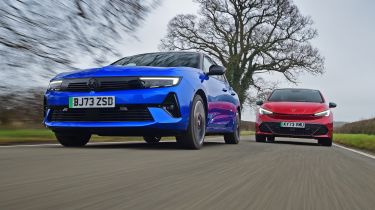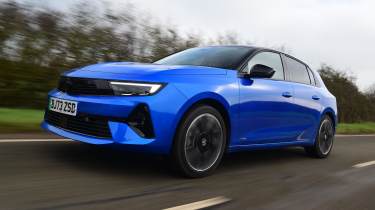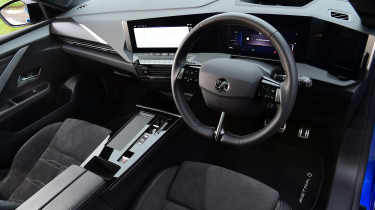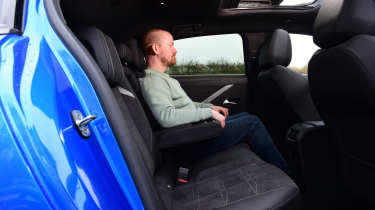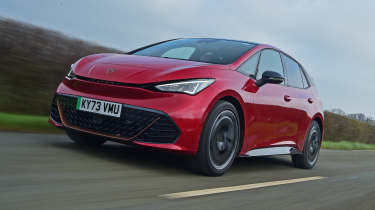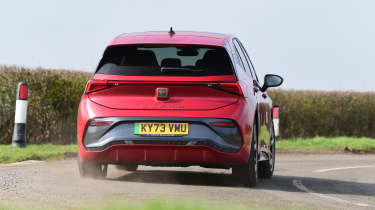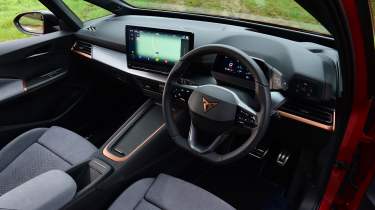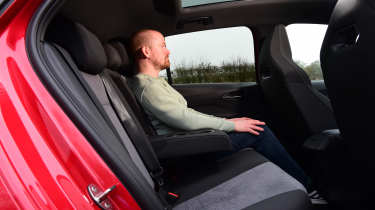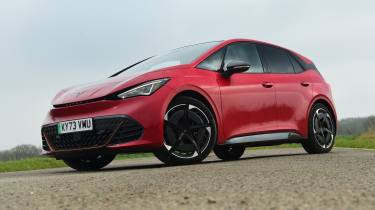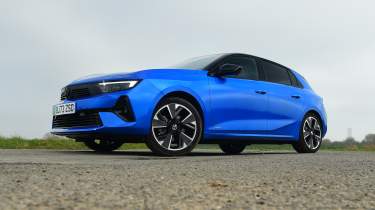Cupra Born vs Vauxhall Astra Electric 2024 twin test: which is the best electric family hatch?
It’s lift off for Vauxhall’s Astra Electric as it looks to be a family-hatch hit. We test it against a Cupra Born
Verdict
Stellantis and the Volkswagen Group are two giants of the automotive industry, with no less than 17 individual marques shared between them in Europe.
Having a variety of brands under one roof typically results in a lot of parts-sharing, and this has been crucial for both companies to help save costs while developing and rolling out electric cars for their assorted makers.
One obvious product of parts-sharing under the Stellantis umbrella is the recently launched Vauxhall Astra Electric. It uses the same platform, battery and electric motor as the Peugeot E-308, as well as several other Stellantis products, while over at VW, the Cupra Born is one of many EVs that share the same running gear.
Not only is this head-to-head comparison about bragging rights, but it also highlights two quite different directions in terms of electrification. Where Stellantis has adapted an existing ICE platform for its EV, the VW Group has engineered one from scratch. Both options mean huge investment, but which offers the best all-round talents?
| Vauxhall Astra Electric 54kWh GS | Cupra Born 58kWh V3 Edition | |
| Price: | £40,145 | £39,500 |
| Powertrain: | 1x e-motor, 154bhp | 1x e-motor, 227bhp |
| 0-62mph: | 9.2 seconds | 6.6 seconds |
| Efficiency: | 3.2 miles/kWh | 3.6 miles/kWh |
| Official range: | 259 miles | 262 miles |
| Annual VED: | £0 | £0 |
Vauxhall Astra Electric
The latest Vauxhall Astra aims to be the most versatile yet, with petrol and hybrid versions offered alongside this all-electric one. The car pictured is in top-spec Ultimate trim, but we’re testing the mid-range Astra GS, which costs £645 more than the range-topping Born with the smaller battery.
Tech highlights
Electric drive was added to the Mk8 Astra at the end of 2022, and because it’s based on the Stellantis EMP2 platform, it has a 54kWh battery, rather than the 50kWh unit found in the first e-CMP-based Corsa and Mokka electric cars. While the Astra is not a bespoke EV like the Born, it still comes with a 259-mile range, which is pretty respectable for a family hatchback. Helping this figure is the Astra’s fairly low drag coefficient of 0.26Cd, which is the same as the super-slippery nineties’ Calibra coupe.
Used - available now

2023 Ford
Kuga
21,659 milesAutomaticPetrol2.5L
Cash £21,697
2023 Skoda
Kamiq
17,635 milesManualPetrol1.5L
Cash £15,197
2021 MINI
Cooper Electric
24,423 milesAutomaticElectric
Cash £12,697
2017 Nissan
Qashqai
34,380 milesManualPetrol1.2L
Cash £10,697The Astra isn’t as sporty as that car, but the electric motor sends 154bhp and 270Nm of torque to the front axle, making it more potent than any pure-petrol version from the current generation.
While the Astra Electric looks identical to its combustion-engined counterparts – an impressive feat, considering the differing priorities for EV cooling and aerodynamics – the packaging isn’t the same, and boot space takes a hit due to the location of the batteries. If carrying capacity is key, the Astra Electric is also offered in Sports Tourer form, making it one of the few all-electric estates on the market.
Safety: The Mk8 Astra was tested by Euro NCAP in 2022 and was awarded four stars – a rating that applies to all powertrains. Whenever a car doesn’t get the full five-star rating, especially a family hatch, it raises a few eyebrows. In the case of the Astra, pedestrian safety wasn’t an area it excelled in and neither was safety assist. Whatever Astra you opt for, you’ll get the same amount of safety kit.
On the road
Don’t push the Astra Electric too hard and your reward will be a well mannered and refined driving experience – although ultimately it’s a little dull.
Around town: The Astra suits urban driving, but perhaps not as well as you’d expect of an electric car. We say this because EVs usually offer instantaneous torque, but in the Astra the throttle response feels numb. The quick steering is a bonus around town, as is the 10.5-metre turning circle – although that’s not quite as tight as the Cupra’s.
As with the throttle, we think the brake pedal could have a better feel. The transition from electric motor regeneration to the mechanical brakes leads to an inconsistent feel, and there’s no one-pedal driving mode, either.
Where the Vauxhall feels better than a lot of its rivals is in the ride quality. It’s heavier than the petrol car due to its battery, but the Astra Electric is composed over rutted roads and speed bumps.
A & B-roads: You’re unlikely to grab the Astra’s keys for a spirited drive. A 9.2-second 0-62mph time is respectable, but the interesting part is how close the driving experience is to the petrol models’.
While the powertrain is noticeably different, there’s not much between them in delivery. The petrol Astra has light yet vague steering, limited body roll and predictable handling, and this is how the electric version performs, too.
Motorway: Hints that the Astra Electric is happiest when at a cruise are most obvious at higher speeds. There is a bit of wind noise around the A-pillars and some unwanted tyre roar, but the Astra is a perfectly pleasant long-distance cruiser. The suspension never feels too harsh on bad surfaces, nor floaty on undulating roads.
Ownership
If you want an EV that blends in, the Astra Electric will suit you. The exterior features Vauxhall’s eye-catching ‘Vizor’ front end, but the overall design is more generic than the Born’s. This theme also extends to the inside, where the Astra EV is identical to the petrol-powered models.
It’s a functional cabin, rather than one that impresses visually. In all-black, it’s quite dark when compared with the more vibrant Born’s interior. The sleeker profile of the Vauxhall means the windscreen feels a little closer to you, and you sit lower than in the Cupra, but the Astra is certainly spacious enough both up front and when sitting in the rear. There’s a little more legroom in the back of the Vauxhall, although headroom is tighter than in its Spanish rival by 4mm.
The fit and finish of the Astra is decent enough, but it lacks any real wow factor. The expanse of piano black on the centre console seems like it’ll scratch within a few months of family life, and in our GS version, rear passengers miss out on the suede-like fabric on the front doors – getting harsh plastic instead. We like the physical controls for common functions under the touchscreen, although the outer ‘buttons’ are touch-sensitive.
In 2023, Vauxhall finished 24th out of 32 makers in the Driver Power customer satisfaction survey. Although Cupra didn’t feature, parent company SEAT did, and the Spanish firm finished one spot ahead of Vauxhall. If something were to happen to the Astra, Vauxhall has a three-year/60,000-mile warranty and eight years/100,000 miles of cover for the battery. Vauxhall guarantees at least 70 per cent charging capacity throughout this period.
Storage: The cabin has deep door bins and a fairly big glovebox. The centre console storage is a little shallow, but there are two cup-holders up front, two Isofix points in the rear and three USB sockets (two up front and one in the rear).
Practicality
The Astra Electric’s practicality is only average for a car in this class.
Rear Space: It’s easy to get comfortable in the back of the Astra thanks to the low window line and enough legroom for
tall adults. The bench seats are quite flat, however, and headroom and elbow don’t quite match the Cupra’s, but we doubt you’ll hear any complaints from those travelling in the Vauxhall’s back seats.
Boot: The Astra Electric is a victim of packaging issues. The use of petrol, plug-in hybrid and all-electric powertrains on the same platform means boot space is hindered by the battery location; it’s down 70 litres on the ICE models to 352 litres. Unlike the petrol models, the EV doesn’t have underfloor storage, either. The Astra is wider than the Born and the boot’s lip height is lower, so more cumbersome objects should be easier to load.
What to buy?
Which version we’d choose…
- Powertrains: The solitary choice for the Astra Electric is the 154bhp electric motor and 54kWh battery tested here. We’ve seen the sportier GSe name used for the plug-in hybrid Astra, but there’s been no word on if that car’s chassis tweaks will carry over to the Electric.
- Trim: The Astra Electric is well equipped even in entry-level Design spec. Unlike petrol models, all the EVs have the same bodykit and 19-inch wheel size. Kit includes adaptive cruise control, twin 10-inch dash displays, wireless Apple CarPlay and Android Auto, plus front and rear parking sensors.
- Our choice: GS and Ultimate boast handy kit upgrades, but Design is the best value.
Cupra Born
If the Astra is a household name, then the Born is a relative unknown. However, step inside and the Cupra feels pretty familiar to other VW Group electric cars – although that means some of the quirks have been carried over, too.
Tech highlights
The Cupra Born sits on the MEB platform, which is the same architecture used for the VW ID.3 and ID.4, Skoda Enyaq and Audi Q4 e-tron. The Cupra’s choice of 58kWh and 77kWh batteries is offered in most of those EVs, and the larger unit is claimed to be capable of up to 343 miles in the Born. What the 58kWh battery loses in range it makes up for with a lower price. There’s a saving of £2,770 in V2 and V3 Edition trims (the 77kWh unit isn’t offered in entry-level V1 spec), which undercuts the Vauxhall Astra Electric.
Despite the Born’s slightly larger battery, there’s nothing to split these two competitors when it comes to range, with both offering around 260 miles per charge. With Cupra’s inherent extra focus on performance over sisters VW and SEAT, the Born’s rear-wheel-drive layout is a sporty alternative to that of the front-wheel-drive Astra.
The Cupra also features a much more powerful 227bhp electric motor, so it is faster in a straight line, with a hot hatch-like 6.6-second 0-62mph time. That’s a full 2.6 seconds faster than the Astra. From the raw numbers, the Born should be the model that appeals most to keen drivers.
Safety: When Euro NCAP tested the Cupra Born in 2022, it awarded the Spanish electric hatchback a maximum five-star rating. The model performed especially well when it came to adult and occupant safety. Pedestrian safety was not so good, however, with the Born’s A-pillars in particular offering poor protection in the event of an impact.
On the road
Cupra’s reputation for sporty, engaging cars extends into the EV world with the Born.
Around town: The Born is an excellent urban runabout, thanks to its responsive powertrain, excellent visibility and compliant ride – which feels better at low speeds, with a less fidgety nature than the Astra’s. As with the Vauxhall, the Cupra’s steering is light, with a front end that seems quick to react to driver inputs.
What you don’t notice in urban driving as much is the Cupra’s initial brake pedal travel, which is spongier than the Vauxhall’s. There’s also an obvious transition from brake regeneration to the discs and pads in the slightly less intuitive Born.
A & B-roads: If you’re looking for a fun B-road blast, then the Born manages to provide enough entertainment. We’d like the traction control system to be a little less intrusive, but you can have some fun with what is a usable rear-driven chassis.
The 227bhp electric motor serves up plenty of poke, although there’s a typical drop off in power delivery the faster you go.
Despite an extra 104kg of weight over the Astra, the Born feels the more lively of the two cars. Get overzealous with your steering inputs with either of these models and you’ll find safe, predictable understeer is the order of the day, though.
Motorway: At motorway speeds the Born doesn’t feel as tied down as the Astra, but driving the Cupra on a long journey is no chore. Road noise from the tyres is the most noticeable drawback to refinement, but in terms of high-speed ride quality, the Born largely impresses.
That quick steering you experience at low speeds thankfully settles down the faster you go.
Ownership
The Born has a bespoke EV platform, but still uses parts that are shared with the wider VW Group. For example, the 12-inch, high-resolution central touchscreen is used in the Cupra Formentor SUV, although the Born gets some additional EV functionality. The infotainment is pretty easy to understand, but the touch sliders for the climate and audio volume remain an annoyance.
The flat-bottomed steering wheel with perforated leather is a classy touch, but the touch-sensitive buttons are a pain to use, with the outer ones often accidentally pressed. More frustrating buttons are provided for the window controls: there’s a switch that swaps between operating the front and rear windows, but we’d prefer four individual controls.
We like the Born’s sports seats, which offer good support and a decent level of comfort, while the overall cabin plays into a minimalist theme pretty successfully without being too dull, courtesy of the copper-coloured trim pieces.
Also Cupra recently increased its warranty from three years and 60,000 miles to five years and 90,000 miles, making it one of the most competitive aftersales agreements on the market. It even trumps its Volkswagen parent company, which is still limited to 36 months.
As with the Astra, the Born’s battery is under warranty for eight years or up to 100,000 miles, whichever comes first. The Born requires a service every two years on Cupra’s maintenance plan. But if your Born has the e-Boost function with the uprated Brembo brakes, you won’t be able to make use of the brand’s in-house service scheme.
Storage: A sliding cover over the centre console reveals two cup-holders, while high-spec cars also have a wireless smartphone charger. There’s a fold-out central rear armrest plus two additional cup-holders. The door bins are pretty spacious and the sliding central armrest contains a storage area.
Practicality
The Born should suit family life because it scores well for usability.
Rear Space: The Born’s upright profile and high roof mean it has plenty of headroom front and rear. In the back there’s also good legroom, although not quite as much as in the Astra. The Cupra fights back when it comes to width, though, with an extra 11mm of elbow room. Middle-seat passengers should be more comfortable here than in the Astra, thanks to the Born’s flat floor.
Boot: With its bespoke EV platform, the Born has better packaging when it comes to boot space. A 385-litre volume is around par for a family hatch, but remember that there’s an electric motor beneath it too. Fold the rear seats and there’s 1,267 litres on offer, but they don’t fold completely flat. An optional false floor helps to mitigate the Cupra’s high loading lip.
What to buy?
Which version we’d choose…
- Powertrain: If you want to tap into the Born’s playful dynamics, then the more powerful 227bhp electric motor
- is best – but the 201bhp version is no slouch either. The choice between the 58kWh and 77kWh batteries is a tough one, because while the extra range is useful, so is the £2,770 cheaper price for the smaller battery.
- Trim: The V3 Edition comes with an uprated sound system, a panoramic roof, and 20-inch wheels as standard. But lesser Borns are still well equipped, with a saving of around £1,800 between the V3, V2 and entry-level V1.
- Our choice: V2 with the 77kWh battery and 227bhp motor should cater for most needs.
Results
Which car comes out on top?
Winner: Cupra Born
A bespoke EV platform really helps the Born’s practicality, and when you combine that with an excellent drive, you’re onto a winner.
It doesn’t quite live up to its hot-hatch billing, but there’s fun to be had, while a lower list price and better efficiency mean that the Cupra also appeals to the head. Frustrations with the infotainment system and ergonomics could be a stumbling block for many people, although if you can manage to look past this, the Born is an excellent compact family EV.
| Pros | Cons |
| Stylish looks | Annoying touch controls |
| Well equipped | Some hard cabin plastics |
| Two battery options | No under-bonnet storage |
| Engaging dynamics | Road noise on big wheels |
Runner-up: Vauxhall Astra Electric
Kudos goes to Vauxhall for offering the latest Astra with a convincing line-up of powertrains; it’s just that the all-electric version isn’t our pick of the bunch.
The Astra is immediately put on the back foot by being more expensive than the Born, while its test efficiency wasn’t as good. It claws back marks for its refinement, and standard kit, but the Cupra has the edge for driving enjoyment, as well as more choice in terms of battery size and trim levels.
| Pros | Cons |
| Eye-catching looks | Dark interior |
| Comfortable at a cruise | Smaller boot |
| Good standard kit | Not as fun to drive |
| Heat pump is standard | No larger-battery option |
Rivals and other options
The Born wins our test, but what else is out there?
- Same class: MG4
- Same class: Volkswagen ID.3
- Used: Polestar 2
- Used: BMW i4
- Coming soon: Ford Explorer
The great debate
The Auto Express team have their say…
John McIlroy, editor-at-large: “Choose either of these cars in a more basic trim level and you won’t feel short-changed on kit, with LED lights, navigation and adaptive cruise control as standard across both ranges. However, it’s the wider choice of powertrain options that puts the Born ahead for me.”
Richard Ingram, deputy editor: “Vauxhall recently reduced the prices of its Corsa and Mokka Electrics with the introduction of a new Griffin trim level. This knocks around £7,000 off the price of the Mokka, and I wouldn’t be surprised if there are similar savings in the pipeline for the Astra Electric.”
Dawn Grant, picture editor: “It’s impressive that the Astra Electric can still take on the Born even though it’s based on an architecture that was originally designed for combustion-engined vehicles. However, there are still some key areas where the Cupra’s bespoke EV layout shines though.”
Alex Ingram, chief reviewer: “The Astra Electric hatchback was beaten by the Born here, but it’ll be a different story for the Sports Tourer estate. With precious few electric load-lugging rivals (the E-308 SW and MG5 are the only ones at this price point), it’s arguably the best choice in the sector.”
Dean Gibson, senior test editor: “Cupra is pitched as a sporty brand, but while the Born does have a racy edge when compared with the Astra and other MEB-based models, it doesn’t quite hit the hot-hatch brief. Maybe the forthcoming Raval supermini will be even closer to the mark.”
Which would you buy? Let us know in the comments section below…
Specs and prices
| Vauxhall Astra Electric GS | Cupra Born 58kWh V3 Edition | |
| On the road price/total as tested | £ 40,145/£40,145 | £39,500/£39,500 |
| Residual value (after 3yrs/36,000) | £17,584/43.8% | £19,158/48.5% |
| Depreciation | £22,561 | £20,343 |
| Annual tax liability std/higher rate | £160.36/£320.70 | £158/£315.60 |
| Annual elec. cost (10k/20k miles) | £919 (£1,531) | £817 (£1,361) |
| Ins. group/VED | 26/£0 | 27/£0 |
| 3-year service cost | £594 | £479 (first 2 services, yr 2 & 4) |
| Length/wheelbase | 4,374/2,675mm | 4,324/2,766mm |
| Height/width | 1,441/1,860mm | 1,540/1,809mm |
| Powertrain | 1x electric motor/lithium-ion battery | 1x electric motor/lithium-ion battery |
| Peak power | 154bhp | 227bhp |
| Transmission | Single-speed auto/fwd | Single-speed auto/rwd |
| Battery capacity/usable | 54/50kWh | 62/58kWh |
| Boot capacity front/rear seats up/down | 352/1,268 litres | 385/1,267 litres |
| Kerbweight/Payload/Towing weight | 1,679/421kg/N/A | 1,765/525kg/N/A |
| Turning circle | 10.5 metres/repair kit | 10.2 metres/repair kit |
| Basic warranty/recovery | 3yrs (60,000)/1yr | 3yrs (60,000)/2yrs |
| Driver Power manufacturer/dealer position | 24th | 23rd (SEAT) |
| Euro NCAP: Adult/child/ped./assist/stars | 80/82/67/66/4 (2022) | 93/89/73/80/5 (2022) |
| 0-62mph / top speed | 9.2 seconds/105mph | 6.6 seconds/99mph |
| Auto Express economy(miles/kWh)/predicted range | 3.2/160 | 3.6/209 |
| Claimed range (WLTP) | 259 miles | 262 miles |
| Charging capability | 7/11/100kW | 11/120kW |
| Charging time | 8h/5h 45 min/26 min (20-80%) | 6h 15 min/35 min (5-80%) |
| Number of airbags / Isofix points | Eight/two | Six/two |
| Parking sensors/camera | Front & rear/360 degree | Front & rear/yes |
| Lane-keep assist / blindspot / AEB | Yes/no/yes | Yes/no/yes |
| Climate control/adaptive cruise ctrl | Two-zone/yes | Two-zone/yes |
| Leather / heated seats / wheel | Part faux/yes/yes | No/front/no |
| Metallic paint/LED lights | £600/yes/no | £590/yes/£970 |
| Keyless entry & go/powered tailgate | Yes/no | Yes/no |
| Sat-nav/digital dashboard/USBs | Yes/yes/three | Yes/yes/four |
| Online services/wireless charging | Yes/no | Yes/no |
| Apple CarPlay/Android Auto | Wireless/wireless | Wireless/wireless |

